Antibiotics: Prevention out – treatment in?

The banning of collective and preventive antibiotic treatment of animals is advocated by the European Parliament’s Environment and Public Health Committee (COMENVI). That equals ‘attempting to cripple EU agriculture by over-restriction of the use of antibiotics’, David Burch explains.
I think most people would agree that antibiotics should not be used ‘to improve performance (i.e. growth promotion) or compensate for poor animal husbandry’ but it does not take into account infectious agents are passed from the sow to the piglet and may result in clinical disease at times of stress e.g. post-weaning or when natural maternally-derived immunity (antibodies) and resistance wanes or immuno-compromising viruses such as PRRS virus or Mycoplasma infections strike.
Dangers of limiting prophylactic antibiotic use
The Members of European Parliament (MEPs) wish to ‘limit the prophylactic use of antimicrobials (i.e. as a preventive measure, in the absence of clinical signs of infection) to single animals and only when fully justified by a veterinarian.’
The problem arises that when you have 200 weaned pigs each week you are not sure which individuals are carrying Streptococcus suis and are likely to break with septicaemia, meningitis, infectious arthritis, pericarditis and potentially die. To limit prevention to individual animals is naive and impractical, unless you wish to return to owning a single pig in a sty at the bottom of the garden.
So saying, national governments do not appear to be supporting prophylactic use, as I think they feel this is an easy way to reduce the use of antibiotics in the EU.
Also interesting: The classification of antimicrobials – a clash of views
David Burch: Over recent years there has been a divergence in views between the World Health Organisation (WHO) and thankfully, the European Medicines Agency (EMA) over the classification of antimicrobials and their use in human and veterinary medicine.
Metaphylactic use for just 1 pig – not practical
The next attack is on metaphylactic use or early treatment (i.e. treating a group of animals when one shows signs of infection). This ‘must be restricted to clinically ill animals and to single animals that are identified as being at a high risk of contamination, in order to prevent bacteria from spreading further in the group.’
This may be fine when one is keeping a single animal in a pen such as a calf but normally pigs are kept in pens of 20, in rooms of 200 and in houses, potentially of 2,500 plus. So which individual animals in the pen am I going to give metaphylactic treatment to – they all need it? Treatment is often by injection but nobody wants to treat houses of pigs individually when they are breaking down with pneumonia or swine dysentery. The infection is circulating in the house and can break out anywhere.
Picking up the common cold virus
‘MEPs urge farm animal owners and keepers to use stocks with suitable genetic diversity, in densities that do not increase the risk of disease transmission and to isolate sick animals from the rest of the group.’
This all sounds great but I think they should go back to when they had children at school and they all pick up the common cold virus at the beginning of term and come home and infect the rest of the family. Genetic diversity and density in a school room plays no relation to the spread of common infections when there is a common air space or common dunging area. Usually, we already use hospital pens for the very sick.
They appear to have no understanding of the spread of infectious diseases or population medicine and one wonders if they have ever been on a pig or poultry farm?
Attribution of resistance from animals to man
I have been working on this recently and a number of papers have shown that only 0.27% of ESBL (extended-spectrum beta lactamase) or cephalosporin resistance genes found in Escherichia coli causing disease in man are associated with animals or meat or animal health use of these antibiotics (Burch, 2015). It is stated that animal health use of antibiotics has a major impact on human health especially from zoonotic infections such as Salmonella and Campylobacter, which may be resistant to antibiotics.
A common set of figures quoted (COMENVI report, 2015) are that there are 25,000 deaths associated with antimicrobial resistance in the EU, 2.5 million extra in-hospital days and a €1.6 billion extra societal costs such as healthcare expenses and productivity losses.
Gastro-intestinal infections are not pleasant but figures from the EFSA/ECDC report (2014) indicate that an estimated 64 deaths (0.03% of reported cases) were caused by Campylobacter in the EU and not necessarily resistance associated and 127 deaths (0.14% of reported cases) from Salmonella, again not necessarily resistance related. The patients may have had other health disorders as well, especially the aged.
Even if the figures are projected to include all the Salmonella and Campylobacter mortalities as well, it is still a relatively small number (258.5 or 1.0%) in comparison with directly human-associated use of antimicrobials. Animal health use is not associated with other human last-resort antibiotics carbapenem, tigecycline or fosfomycin resistance in the EU, or multi-resistant tuberculosis in man.
Good news – colistin
In the Chinese paper (Liu and others, 2015) that has caused so much recent controversy, they described a new transferable antimicrobial resistance gene mcr-1, associated with colistin resistance found in a plasmid in E. coli. In 2014, they found 21% of pigs and 22% of pig meat and 28% chicken meat to be carrying E. coli with the mcr-1 gene. Fortunately, they found a lower incidence in hospital in-patients of 1.4% in E. coli and 0.7% in Klebsiella pneumoniae.
Also interesting: Colistin resistance – a mini survey in the EU
David Burch looks at the use of colistin: Nobody seemed too worried about colistin resistance, as it was mainly used in animal medicine and there were basically few resistance issues. We were focussing on cephalosporin and fluoroquinolone resistance. Now that it has started to be used in human medicine as a ‘last resort’ drug, after the carbapenems have failed, it is coming under the microscope.
Conjugation vs transformation
They carried out plasmid transmission studies and found that the pig E. coli strain could transmit the plasmid to another pig strain by ‘conjugation‘ (a mating-like process), the most common route, where the plasmid is passed directly into another bacterium. This probably accounts for the high incidence in pigs. Fortunately, the transfer from pig E. coli isolates to human isolates was not by conjugation but by a much slower route called ‘transformation‘, where the bacterium has to pick up the DNA/plasmid in the environment as it matures.
Human Klebsiella and Pseudomonas aeruginosa also had to pick it up by transformation and this may account partially for the much lower transmission of resistance from animal to human bacterial isolates. Retrospective studies in the EU have shown the presence of the gene in isolates since 2005 and in calves, poultry and pigs but fortunately there has been very little transference to human cases so far.
Work is ongoing at the EMA (European Medicines Agency) to evaluate the colistin resistance potential risk from animals to man in the EU and we await with interest the results of their deliberations.











